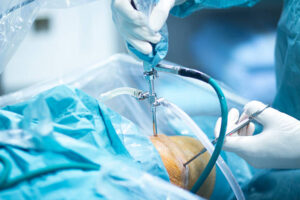 Liège, October 4 2023 – A study highlighted the technical feasibility of telemedicine for post-operative follow-up in orthopedic surgery, with a high patient satisfaction rate in terms of patient/doctor interaction, impact on daily life, and usability.
Liège, October 4 2023 – A study highlighted the technical feasibility of telemedicine for post-operative follow-up in orthopedic surgery, with a high patient satisfaction rate in terms of patient/doctor interaction, impact on daily life, and usability.
Telemedicine has recently seen significant developments, particularly during the 2020 pandemic, when numerous teleconsultations were set up to ensure continuity of care. Studies suggest that telemedicine holds great promise for remote medical and surgical follow-up, with efficacy equivalent to that of face-to-face care, even in the context of post-operative follow-up.
Objectives et method
The aim of this study was to evaluate patient satisfaction with a post-operative follow-up combining a teleconsultation with a face-to-face consultation in the orthopedic surgery department of CHU St-Pierre in Brussels, with the teleconsultation replacing the first post-operative consultation. The qualitative, prospective, observational study was conducted over a 2-month period.
According to the protocol’s main inclusion criteria, patients had to be of legal age, able to use a smartphone and enter one of the following 4 pathways: removal of osteosynthesis material, operated fracture of the upper or lower limb, knee arthroscopy and forefoot surgery, in the pre- or post-operative phase. After enrolment, patients are invited to download the Comunicare application, which provides access to information modules, sign and symptom monitoring, clinical questionnaires tailored to their pathology, and a teleconsultation module. At the end of the teleconsultation, patients are invited to complete a satisfaction questionnaire.
Results
Of 53 patients treated in the targeted care paths over the period, 34 were eligible, 30 of whom agreed to be included in the study. In the end, 27 patients benefited from teleconsultation, 22 of them via the Comunicare application (5 teleconsultations could not be carried out via Comunicare due to the hospital’s network being cut off following a computer attack). Concerning the use of the information and follow-up modules, 15 of the patients considered that Comunicare improved access to care, given the grouping and quantity of information provided by the application, and 6 indicated that the information provided had encouraged them to learn more about their pathology.
Overall, 92.6% to 100% of patients said they were satisfied or very satisfied with the surgeon’s attitude, the information received and the teleconsultation. As for the preference between a teleconsultation and a face-to-face consultation, 81.5% of responses were positive or very positive, while the reservations expressed (11 patients, or 50%) concerned the lack of a physical examination.
Conclusions
The study highlighted the technical feasibility of teleconsultations, with a high level of patient satisfaction in terms of patient/doctor interaction, impact on daily life, and usability. The main source of patient satisfaction is time savings. The main perceived disadvantage is the absence of a physical examination. Information and sign/symptom monitoring functionalities were little encouraged and therefore little used, but perceived positively by patients. Finally, as this study focused on patient satisfaction, it did not address the problems associated with the internal organization within the hospital for the implementation and generalization of such a practice.

Commentaires récents